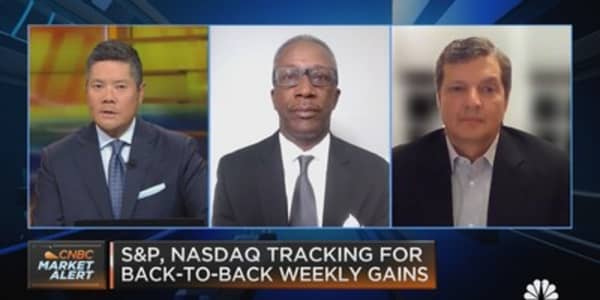CNBC reported that Sotheby's recently sold a century-old bottle of Louis XIII Cognac for $134,750, making it one of the most expensive bottles of wine ever auctioned.The auction house said the cognac sale was part of more than $5 million worth of wine it sold over the Sept. 10-11 weekend. Think its new owner will actually drink it? Think again; the cognac, which dates back to the 1870s, is likely an investment by a wine aficionado, but one who values profit over taste.
It can be risky but also full of rewards. And there are often few immediate dividends apart from emotional ones.
From art, antiques and vintage autos to whiskey and wine, here's a look at alternative investments that do double duty as both passions and profit generators.
"I don't believe collectibles are a wise vehicle for the average investor. Collecting to make a profit is challenging and should be left to the specialists in their respective fields," said Steve Lear, principal and financial planner at Affiance Financial. "If investors are inclined to collect, they should do so not with the intention of making a profit, but to enrich their lives by doing something that brings them joy."
This story, originally posted 4 December 2013, has been updated to reflect recent auction news on collectibles.
Time to get rich
Collectors of clocks and watches — a tad more common than Pez dispensers and duck decoys — have, of course, their own organization: the National Association of Watch and Clock Collectors, which owns and operates the National Watch & Clock Museum in Columbia, Pennsylvania.
Watch and clock collections can really bring in the big bucks and appreciate in value over ... time. Prices paid at auction for the most highly prized timepieces run into the millions of dollars. For example, the one-of-a-kind 18-karat "Henry Graves Supercomplication Watch" from Swiss luxury watchmaker Patek Philippe — designed for banker Henry Graves Jr. back in 1933 — was auctioned at Sotheby's in late 1999 for an eye-watering $11 million-plus.
Everything old is new again
As the popularity of TV shows such as "Antiques Roadshow" proves, collecting antiques — or what's hoped are antiques — is hardly the rarified pursuit of only the elite or erudite. With luck, that end table inherited from a great-aunt just may turn out to be worth a little something, after all.
Some casual collectors, however, eventually morph into serious investors, turning their appreciation of older objects into an investment strategy. But given wild price fluctuations, a lack of regular income, high fees and the illiquidity of this type of physical asset, antiques investing is a long-term proposition more akin to investing in real estate. Park your money in antiques only if you're prepared to sit on it — the funds, not the furniture — for a good long while.
For art's sake
One lucky man from Indiana bought a painting at a garage sale for a mere 50 cents more than a decade ago, only to realize last year that it was worth $10,000. In 2013, three lucky New Yorkers bought graffiti-style canvasses, priced at $60 each, from a Central Park stall. Unbeknownst to them, the artwork was by renowned, reclusive British street artist Banksy, whose works can sell for hundreds of thousands of dollars at auction.
Not all art collectors will see that unexpectedly big a return from investing in fine art, but there is money to be made over the long term.
Investing in antiques is a big business, worthy of its own index, such as the Mei Moses Art Indices. But according to Michael Moses, a founder of both the index and Beautiful Asset Advisors, art investing is not just for the very rich. "There's a painting for every purse," he told CNBC in a 2013 interview, adding that low-priced art tends to outperform more costly works. Someone with a $500,000 portfolio could consider putting 10 percent to 20 percent in illiquid assets, including art, he said.
Vroom vroom
We've all heard a new car loses up to a fifth of its value as soon as it's driven off the lot. But investors are nonetheless gunning their engines for classic cars, a flashy alternative-asset class that rose in value by more than 16 percent in 2015.
That's according to independent investment research house and think tank Historic Automobile Group International, whose HAGI Top Index indicates that vintage vehicles have outperformed many other collectibles — including art, gold and wine — as investments for the past decade.
That's because collectible classic cars are in, well, a class by themselves. The passion they inspire among avid collectors fuels sky-high bidding wars at vintage auctions and private sales.
Welcome to the hood
A subculture of automobile aficionados values anything related to cars — from antique chauffeurs' hats and licenses to spark plugs and classic hood ornaments. "Hood ornaments can go for a fortune," said Terry Kovel, co-author of "Kovels' Antiques and Collectibles Price Guide." Indeed, one was listed on eBay in 2014 for $199,999.
Change is good
Who doesn't have a jarful of loose change somewhere at home? While we're all casual numismatists on some level, collecting and eventually reselling rare coins is not only a popular pastime but also a serious investment tactic. This is, literally, making (new) money from (old) money; the market is estimated at $5 billion here in the United States, according to a January industry report.
As with art, antiques and other collectibles, investing in coins is a long-term proposition. The immediate risks include counterfeits, charlatans and constantly changing prices. But study the market and the materials with care and you could make a profit on your rare coins, albeit decades down the road. In the meantime, your coin collection can become a carefully collected family heirloom, connecting several generations in a shared hobby. Break open that piggy bank and poke around.
No laughing matter
It's no joke: Trading in comic books, once the disposable domain of teenage boys, is growing in popularity as an investment option. As comics-related characters are increasingly spun off into fortune-founding TV, movie and video game franchises, the value of rare and mint-condition comic books has risen. In an extreme example, a single copy of the June 1938 edition of "Action Comics 1," considered the granddaddy of the superhero genre, sold for more than $2 million back in 2011.
As investing in comic books is a relatively recent phenomenon, there's no telling whether the segment will continue to grow or fizzle a bit like the related animation-cel market has since its late '80s, early '90s boom.
Stamps of approval
You can't lick stamps, at least the U.S. Postal Service's "Forever" series, as a sound investment. With rates constantly rising — stamps now cost nearly 30 percent more than they did a decade ago — stocking up on postage at today's prices for use or resale down the road is a surefire, if strange, way to save money. But hoarding modern-day American stamps is just one way to "invest" in postage, precancellation.
Collecting vintage stamps, or philately, for investment purposes became wildly popular in the 1970s. Prices have slumped since then and experts differ on whether stamp-collecting for profit is still a good idea. Stamps with misprints and stamps associated with a certain historical period — say, prerevolution Russia or colonial India — tend to rise in value. The practice has its champions and detractors, but again, the main benefit from stamp-collecting is the pleasure derived in the process.
The big drink
Some wine connoisseurs are sampling fine vintages as an investment vehicle, although the associated costs and pitfalls may give the risk-averse or less-knowledgeable among them a hangover. Excellent wines do indeed appreciate in value with time, but it's really improved taste that interests most experts in the field. It's best to invest in French reds such as Burgundies and Bordeaux, which are more likely to get better with age than white wines, according to wine investor and certified specialist of wine, Stephen F. Lovell. Lovell is also a certified financial planner and branch manager for LPL Financial.
Risks include capricious critics panning your vintage (leading to lower demand) or investing in wine that turns out to be counterfeit — or vinegar. Maintaining and then making a profit off a wine investment takes a lot of time and treasure. And you're not likely to beat market gains. So be sure to buy vintages that appeal to your own taste buds, because your ultimate enjoyment may come from drinking up glassfuls, not profits.
Investing in whiskey is a relatively new pursuit. The market is smaller than that for wines, but that makes it an ideal one for trendsetters to get in on the ground floor. Whiskey collectors should focus on "single-barrel" whiskeys, where the supply is limited to the bottles from one cask — a supply that will diminish over time, said Kenneth Waltzer, managing director and co-founder of KCS Wealth Advisory.
Avoid blended spirits; they're too consistent, and collectors want something unique. All whiskeys are more consistent and stable than wines, and so are the prices. Don't expect to toast any wild gains — or drown your sorrows over major losses — from your whiskey investment.
Horsing around
Talk about literally placing a bet. Investing in racehorses entails some of the biggest highs and lows, both financial and emotional, in alternatives, say those in the know. Well-heeled horse lovers with money to lose cough up tens of thousands, if not millions, of dollars to buy one promising animal, with an eye toward racing wins or, later, breeding fees — an approach akin to stock picking. They either win, or lose, big.
The less affluent or daring, however, can hoof it to syndicates — think mutual funds — that pool investor money to buy a team of horses, sharing in both the considerable expenses and potentially large profits. Either way, buying into a living, breathing asset like a racehorse is a unique investment on both financial and emotional levels.





